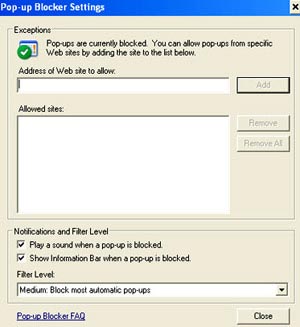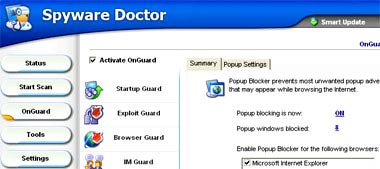3 'blows' take down pop-ups
While accessing the network, naturally strange websites appear to be quite annoying, even hidden spyware. Computer users can apply blocking methods right in the browser, using the tool bar of Google, Yahoo, MSN . or anti-pop-up programs.
1. Block pop-ups in the browser
Devices running Windows XP Service Pack 2 will have an effective pop-up blocker. On the Tools menu, select Pop-up Blocker. After clicking Turn On Pop-up Blocker, the Pop-up Blocker Settings section will be activated. In the window that appears, users can choose the pop-up blocker level (low, medium, high). However, there are some pages that display links in the form of pop-ups so when using the blocking feature, users will not be able to read. Therefore, for certain pages that are safe, you can enable pop-ups in the Address of Website to allow box. Other Windows versions do not have this feature.

The window of setting up anti-pop-up options in IE.
Other browsers have been able to block pop-ups, even before Microsoft decided to integrate this feature into Internet Explorer (IE). Mozilla's Firefox is a browser with many outstanding features, in which pop-up blocking is quite effective. Crazy Browser has been around since 2002 and also shows similar features. However, to run Crazy Browser, you still have to install at least IE 5.0 and Windows operating system (version 95 and above).
2. Use 3rd party toolbar in the browser

Google Toolbar
There is an increasing trend on websites that allows some companies' toolbars to be on IE. Toolbar offers many unique features, including the ability to block pop-ups. Google, MSN and Yahoo are some of the best names that offer this service. Although the ability to block pop-ups is quite good, these toolbar can get information about your surfing habits to serve its service development goals. If you feel the tool bar is a good solution, choose for yourself a trusted name and a readable commitment for users.
3. Use pop-up blocking software
These block programs have dozens or even hundreds of different sources. Prior to the various interfaces and the price from free to 30 USD (or more), users may feel confused. However, you can use Spyware Doctor with OnGuard function enabled. In addition, Spybot Search & Destroy, STOPzilla, Secure IE, Zero Popup, Pop Swatter . are also programs that can help block uninvited windows.

OnGuard in Spyware Doctor has anti-pop-up capability.
You should read it
- How to prevent GIFs from automatically playing in the browser
- How to Block pop-ups
- How to block hateful ads on Microsoft Edge browser
- Instructions to block pop-ups in all browsers
- How to Block Popups on Android Browser
- How to block ads on the Samsung Internet browser
- Do you know how to block websites on Chrome?
- How to block pop-up ads on Android devices
- How to block Flash from accelerating Chrome browser
- How to block websites that open on Coc Coc 100% successfully
- How to Block Website Redirects
- Block ads on iPhone with AdGuard






 Air conditioner not cool? The cause and how to fix it
Air conditioner not cool? The cause and how to fix it The killer bird blinds and defeats poisonous African snakes
The killer bird blinds and defeats poisonous African snakes Device to charge the phone with water and wind for phượt people
Device to charge the phone with water and wind for phượt people Where is the origin of blowing candles in your birthday?
Where is the origin of blowing candles in your birthday? Can Pokemon Go be played on a computer? The answer is yes!
Can Pokemon Go be played on a computer? The answer is yes! Summary - How to play Pokemon GO, virtual reality game catch Pokemon on smartphone
Summary - How to play Pokemon GO, virtual reality game catch Pokemon on smartphone